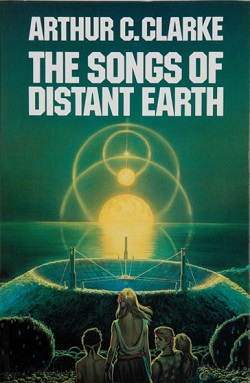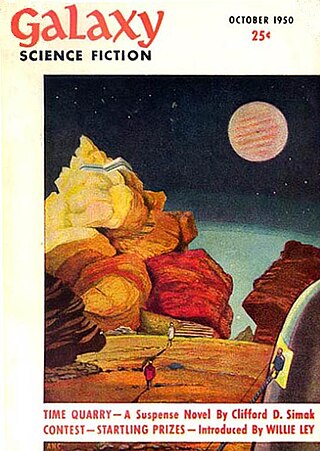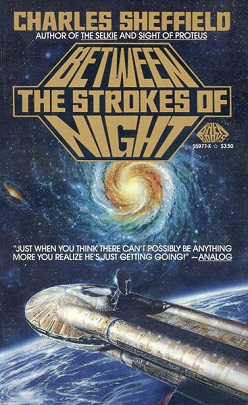
Nemesis is a science fiction novel by American writer Isaac Asimov. One of his later science fiction novels, it was published in 1989, three years before his death. The novel is loosely related to the future history of his Robot Series, Empire Series, and Foundation Series, into which Asimov attempted to integrate his science fiction output. This novel is connected to Asimov's other works by several ideas from earlier and later novels, including non-human intelligence, sentient astronomical bodies ("Hallucination"), and rotor engines.

The Naked Sun is a science fiction novel by American writer Isaac Asimov, the second in his Robot series. Like its predecessor, The Caves of Steel, this is a whodunit story. It was first published in book form in 1957 after being serialized in Astounding Science Fiction between October and December 1956.
"Blind Alley" is a science fiction short story by American writer Isaac Asimov. It was first published in the March 1945 issue of Astounding Science Fiction, and later included in the collection The Early Asimov (1972).

The Songs of Distant Earth is a 1986 science fiction novel by British writer Arthur C. Clarke, based upon his 1958 short story of the same title. He stated that it was his favourite of all his novels. Clarke also wrote a short step outline with the same title, published in Omni magazine and anthologized in The Sentinel in 1983.

The Jesus Incident (1979) is the second science fiction novel set in the Destination: Void universe by the American author Frank Herbert and poet Bill Ransom. It is a sequel to Destination: Void (1965), and has two sequels: The Lazarus Effect (1983) and The Ascension Factor (1988).

Coyote (2002) is a science fiction novel by American writer Allen Steele, the first in a series of eight books. It is a fixup of several of Steele's previously-published short stories, beginning with Stealing Alabama in the January 2001 issue of Asimov's Science Fiction.

Lucky Starr and the Oceans of Venus is the third novel in the Lucky Starr series, six juvenile science fiction novels by Isaac Asimov that originally appeared under the pseudonym Paul French. The novel was first published by Doubleday & Company in 1954. Since 1972, reprints have included a foreword by Asimov explaining that advancing knowledge of conditions on Venus have rendered the novel's descriptions of that world inaccurate.
In both science fiction and utopia/dystopian fiction, authors have made frequent use of the age-old idea of a global state and, accordingly, of world government.

Saturn has made appearances in fiction since the 1752 novel Micromégas by Voltaire. In the earliest depictions, it was portrayed as having a solid surface rather than its actual gaseous composition. In many of these works, the planet is inhabited by aliens that are usually portrayed as being more advanced than humans. In modern science fiction, the Saturnian atmosphere sometimes hosts floating settlements. The planet is occasionally visited by humans and its rings are sometimes mined for resources.

Sucker Bait is a science fiction novella by American writer Isaac Asimov. It was first serialized in the February and March 1954 issues of Astounding Science Fiction, and reprinted in the 1955 collection The Martian Way and Other Stories. It has also been adapted as an episode of the BBC anthology television series Out of the Unknown.

The planetary systems of stars other than the Sun and the Solar System are a staple element in many works of the science fiction genre.

The Night of Kadar is a science fiction novel by British writer Garry Kilworth, published in 1978.

Between the Strokes of Night (1985) is a science fiction novel by English-American writer Charles Sheffield. It first appeared in the March to June 1985 issues of Analog Science Fiction/Science Fact before being published by Baen Books in July 1985. The story is divided into two vastly separated periods: the near future of 2010, and the far future of 29,000 AD. Owing to the unique technological mechanisms of the novel, the same cast of characters appears in both parts, though it is not a time travel story.

Mind Transfer is a science fiction novel by Janet Asimov, published by Walker Publishing Company, Inc. in 1988. The novel journeys through the birth, life, death, and second life of a man whose family pioneers human-to-android mind transfer. It also explores the ethical and moral issues of transferring consciousness into an android at the moment of death, and examines the idea of prematurely activating an android which has not yet accepted a human brain scan.

Blindsight is a hard science fiction novel by Canadian writer Peter Watts, published by Tor Books in 2006. It won the Seiun Award for best translated novel and was nominated for the Hugo Award for Best Novel, the John W. Campbell Memorial Award for Best Science Fiction Novel, and the Locus Award for Best Science Fiction Novel. The story follows a crew of astronauts sent out as the third wave, following two series of probes, to investigate a trans-Neptunian Kuiper belt comet dubbed "Burns-Caulfield" that has been found to be transmitting an unidentified radio signal to an as-yet unknown destination elsewhere in the Solar System, followed by their subsequent first contact. The novel explores themes of identity, consciousness, free will, artificial intelligence, neurology, and game theory as well as evolution and biology.
William Greenleaf is an American author. He was born in Illinois, spent most of his life in southern Arizona, and now lives in New Mexico near Santa Fe. He is a graduate of Arizona State University and worked as a corporate strategic and financial planner before changing careers to become a novelist, freelance book editor, and creative writing instructor.

Ash is a fictional character in the film Alien (1979) portrayed by actor Ian Holm who, while known in the UK as a stage actor, was at the time unknown to American audiences. Ash serves as the secondary antagonist of the first film. The character is the science officer of the Nostromo, who breaks quarantine by allowing Kane, a member of the crew, back on board after he has been infected by an alien life form. It is later discovered that Ash is not human, as he appears, but is a Hyperdyne Systems 120-A/2 android, a sleeper agent who is acting upon secret orders to bring back the alien lifeform and to consider the crew and cargo as "expendable".
The Foundation universe is the future history of humanity's colonisation of the galaxy, spanning nearly 25,000 years, created through the gradual fusion of the Robot, Galactic Empire, and Foundation book series written by American author Isaac Asimov.
"Vaster than Empires and More Slow" is a science fiction story by American author Ursula K. Le Guin, first published in the collection New Dimensions 1, edited by Robert Silverberg. It is set in the fictional Hainish universe, where Earth is a member of an interstellar "League of Worlds". The anthology was released in United States in 1971, by Doubleday Books.
A self-replicating machine is a type of autonomous robot that is capable of reproducing itself autonomously using raw materials found in the environment, thus exhibiting self-replication in a way analogous to that found in nature. Such machines are often featured in works of science fiction.














